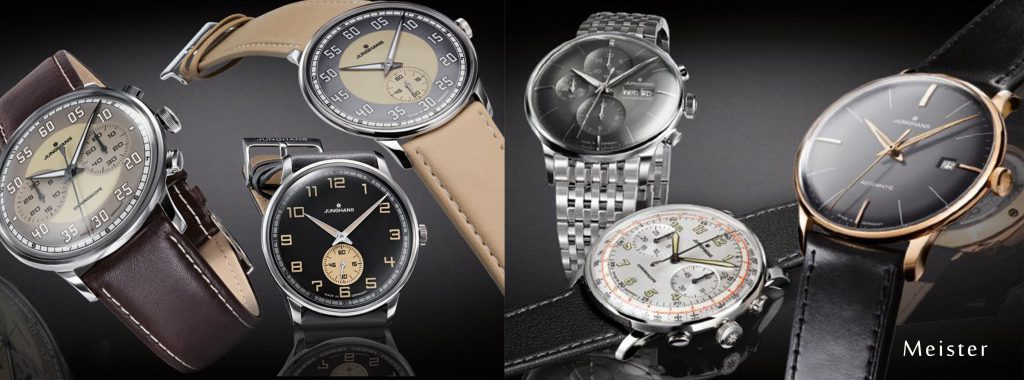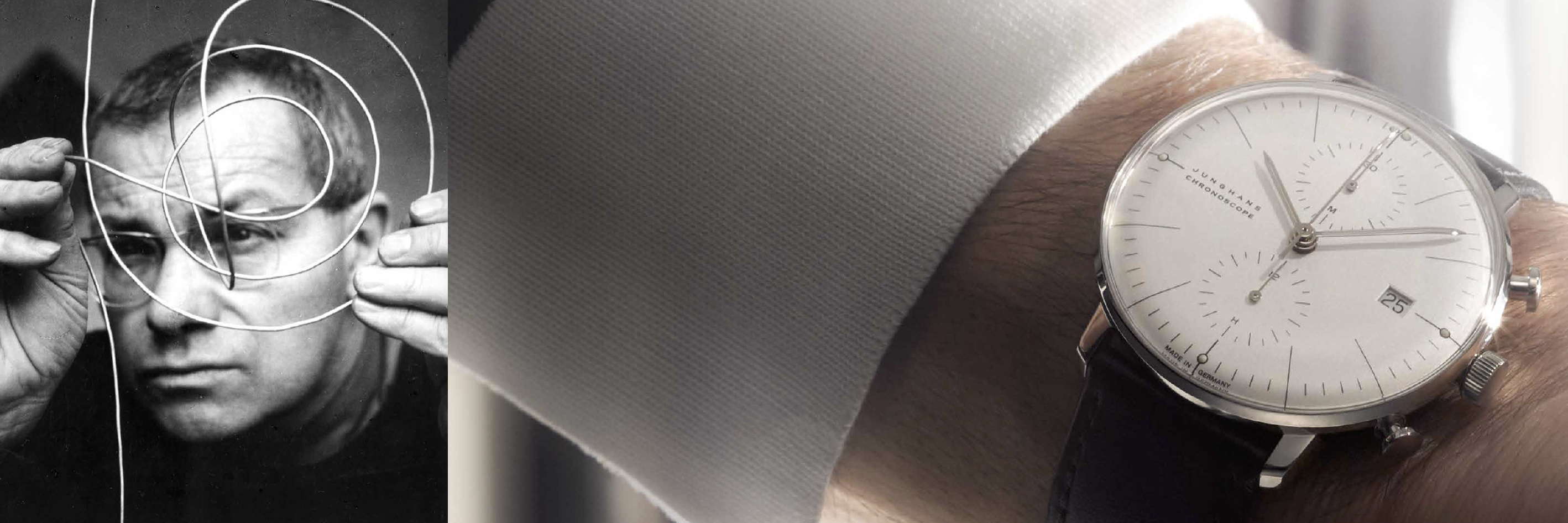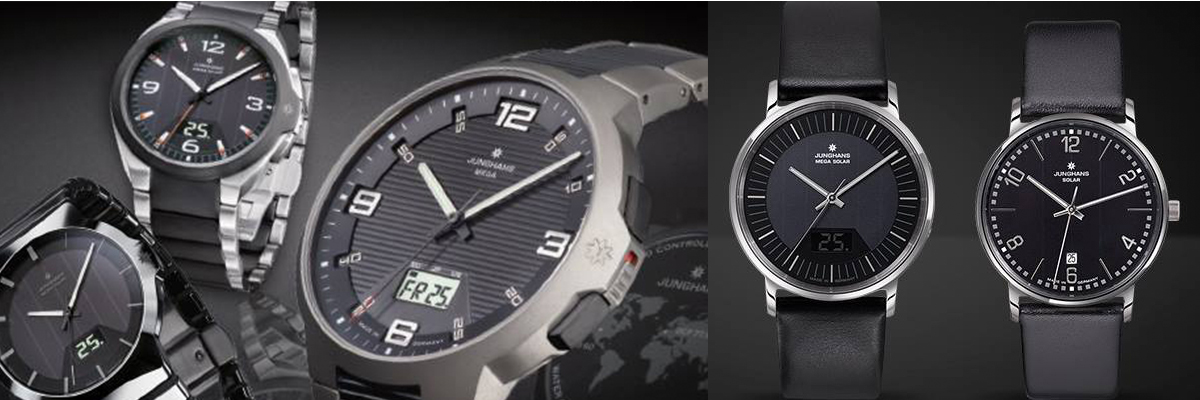Junghans saw the light of day in 1861.
Founded by Erhard Junghans in Schramberg, in the decades that follow the company goes on to write not only industrial but also urban, regional and even architectural history. Schramberg becomes a clock town and the factory premises a world of its own, a town within a town with thousands of employees.


By 1903 Junghans is the world’s largest clock factory since 1918 crowned by the terrace building that still stands prominently in the landscape today, offering the most modern workplaces of the time-bright, light · filled and perfectly structured. This is what makes every timepiece with the star so very unique that we can proudly state – Junghans-the German watch.
Arthur Junghans plans to create workplaces optimally lit by daylight, making them ideally suited for use in high precision manufacturing. To realise this vision he commissions the Stuttgart industrial architect Philipp Jakob Manz, who designs a terraced structure, ascending the Black Forest slope in nine steps. The building is completed in 1918. Around 5oo people work in the 9 terraces, initially producing pocket watches.

JUNGHANS MEISTER - LEGENDS OF THEIR TIME
The high demands placed on timekeeping by aviation were first addressed by Junghans in the 1930s. when the company produced onboard clocks for air traffic use. These were manufactured in level 7 of the now heritage-listed terrace building, the structure offered optimal lighting conditions for the delicate task of watchmaking.
In 1946, plans for the first wrist chronograph with the in-house caliber J88 were completed: a hand-wound chronograph with 19 jewels, ratchet wheel and Breguet hairspring. Series production began in 1949, making the introduction of the reliable calibre in various Junghans models, with 1951 seeing the first appearance of a tachymeter and telemeter function on the dials. In 1955 the newly-established Bundeswehr had a requirement for a service watch for its pilots. The order was won by Junghans, which went on to produce the now legendary pilot chronograph with its dodecagonol bezet (type BW-111).

MAX BILL AND THE ART OF DESIGN
Max Bill was one of the most unusual artists of our time. Acknowledged as a universal genius, he worked as an architect, painter, sculptor and product designer and has left behind an extensive portfolio of creations. This includes one of the most fascinating watch series ever designed-the clocks and wristwatches he created for Junghans-and which remain practically unchanged today. As a Bauhaus student of Walter Gropius, he intuitively understood how to apply the pursuit of constructive clarity and precise proportions to his work. His unrivalled drive to create is also seen in the field of education. He was not only the co-founder and first rector of the Ulm College of Design, but the school building is also a Max Bill original design.

JUNGHANS RADIO CONTROL & SOLAR
In 1985 Junghans produced the first radio-controlled table clock in series. It is accurate to a single second in a million years. In 1990 the team succeeded in miniaturising the radio control technology to the extent that it fitted into a wristwatch. The result: Mega 1, the world’s first radio-controlled wristwatch. Advanced technology in a futuristic design. In 1993 Junghans achieved another global sensation with the Mega Solar. The autonomous wristwatch draws its energy from the sun, whilst the radio signal that it receives means it always displays the exact time. In 2004 came the first multi-frequency radio-controlled wristwatch, receiving time signals on three continents. Since 2011 the extra-slim J615.84 multi-frequency radio-controlled movement has been utilised. Today, radio-controlled watches still offer high-precision comfort. Time does not stand still on the path to absolute precision. Neither do we.

JUNGHANS FORM - DESIGN IN DEPTH
The clarity of the design of the new FORM is matched by the simplicity of the idea upon which it ls based:creating a timepiece that convinces in every situation. Decades of experience has resulted in a new design approach combining modern form with ergonomics - and ultimately a watch of remarkable simplicity. Yet in spite of the restrained design, the FORM has a great deal to discover from every perspective:viewed from the front, in addition to the clear profile it is the three-dimensional dial that stands out-from the side, the gently sweeping form of the case, ensuring superb wearing comfort and making the watch appear even more slender A tinted gloss bock on the automatic models reveals fascinating view of the mechanical movement. These and other details lend the FORM a further aspect beyond its creative stringency an unmistakable character.

A Junghans watch is characterized by meticulousness, skilled craftsmanship and creative nuance. Their designers combine inspiration and tradition with the highest standards of design. To ensure a perfect end product, creative and design processes go hand in hand. The exact dimensioning of all components ensure reliable production and manufacturing processes. And it is not just the finished timepiece that is subjected to an intensive quality inspection, but each individual component - beginning with the realization stage. Only when all components have successfully passed quality inspection are they brought together to create a Junghans. Because our passion is precision.
MILESTONE

Founded in 1861
1866 The first clock launched
1890 Junghans registers a new trademark
1903 with 3000 employees producing over three million timepieces per year
1918 The terrace structure is completed and becomes the landmark of the Shramberg clock factory
1930 Junghans begins to fit movements of its own design and manufacture in wristwatches
1949 Junghans submits the chronograph with the highly robust and reliable J88
1951 Junghans is the largest manufacturer of chronometers in Germany
1956 Become the third largest in the world
1961 Max Bill designs the purist wristwatches and Junghans ensures that the design classics are also in keeping with the latest technical state of the art
1970 Launched the first German quartz wristwatch
1972 As the official timekeeper
1985 Junghans presents the first radio-controlled, series production table clock for private use
1986 Junghans presents the first radio-controlled clock obtain its energy from resource-saving solar technology
1990 The Junghans Mega 1 becomes the first radio-controlled wristwatch in the world
1993 Junghans achieves another coup: the self-sufficient solar-powered wristwatch that always tells the right time thanks to radio signals
2004 With the Junghans multi-frequency radio-controlled movement the dream of a watch that receives time signals in various countries and adjusts itself automatically becomes reality
2008 The model 'Erhard Junghans 1' presented, housed the sophisticated hand-wound calibre J325
2011 150 years of JUNGHANS
2018 Eventful year for Uhrenfabrik Junghans. The 100th birthday of the terrace building is being celebrated with the limited-edition Meister Chronoscope Terrassenbau models
